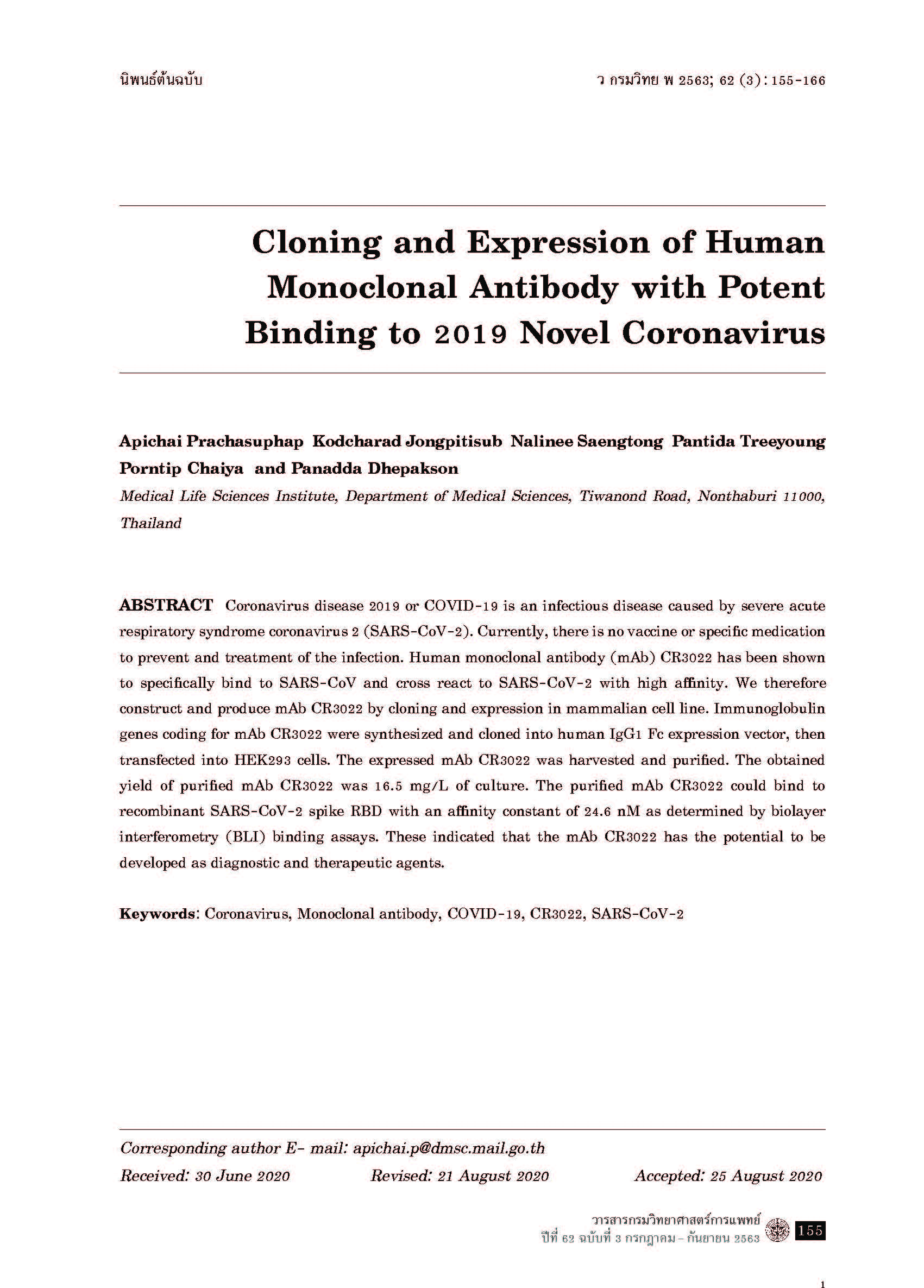การโคลนและการแสดงออกโมโนโคลนอลแอนติบอดีของมนุษย์ที่มีศักยภาพในการจับกับไวรัสโคโรนาสายพันธุ์ใหม่ 2019
คำสำคัญ:
ไวรัสโคโรนา, โมโนโคลนอลแอนติบอดี, COVID-19, CR3022, SARS-CoV-2บทคัดย่อ
โรคติดเชื้อไวรัสโคโรนา 2019 หรือ COVID-19 เป็นโรคติดต่อที่เกิดจากเชื้อไวรัส SARS-CoV-2 ปัจจุบันยังไม่มีวัคซีนป้องกัน หรือการรักษาที่เฉพาะเจาะจง โมโนโคลนอลแอนติบอดีของมนุษย์ CR3022 สามารถจับกับเชื้อไวรัส SARS-CoV ได้อย่างจำเพาะและเกิดปฏิกิริยาข้ามกลุ่มกับเชื้อไวรัส SARS-CoV-2 ด้วยปฏิสัมพันธ์สูง การศึกษานี้ได้สร้างและผลิตโมโนโคลนอลแอนติบอดีของมนุษย์ CR3022 ในเซลล์สัตว์เลี้ยงลูกด้วยนม โดยการสังเคราะห์ยีนที่สร้างโมโนโคลนอลแอนติบอดี CR3022 และโคลนเข้าสู่พาหะสำหรับแสดงออกแอนติบอดี IgG1 ของแอนติบอดีมนุษย์ในเซลล์สัตว์เลี้ยงลูกด้วยนม จากนั้น transfection เข้าสู่เซลล์ HEK 293 จากการแสดงออกสามารถแยกโมโนโคลนอลแอนติบอดี CR3022 ให้บริสุทธิ์ได้จำนวน 16.5 มิลลิกรัมต่อลิตร โดยโมโนโคลนอลแอนติบอดีที่ได้หลังจากทำให้มีความบริสุทธิ์แล้วสามารถจับกับโปรตีนลูกผสมส่วน spike RBD ของเชื้อไวรัส SARS-CoV-2 ได้โดยมีค่าคงที่ของปฏิสัมพันธ์ (KD) เท่ากับ 24.6 nM โดยการวิเคราะห์ด้วยเทคนิค Biolayer interferometry (BLI) แสดงให้เห็นว่าโมโนโคลนอลแอนติบอดี CR3022 ที่ผลิตขึ้นนี้มีศักยภาพในการนำไปพัฒนาการตรวจวินิจฉัย และแอนติบอดีเพื่อการรักษาได้
เอกสารอ้างอิง
Centers for Disease Control and Prevention (CDC). Novel coronavirus 2019 (nCoV-2019), Wuhan, China. [online]. 2020; [cited 2020 Jun 6]; [2 screens]. Available from: URL: https://web.archive.org/web/20200114084712/https:/www.cdc.gov/coronavirus/novel-coronavirus-2019.html.
Gorbalenya AE, Baker SC, Baric RS, Groot RJ, Drosten C, Gulyaeva AA, et al. Severe acute respiratory syndrome-related coronavirus: the species and its viruses – a statement of the Coronavirus Study Group. [online]. 2020; [cited 2020 Jun 6]; [20 screens]. Available from: URL: https://www.biorxiv.org/content/10.1101/2020.02.07.937862v1.full.pdf.
Illinois Department of Public Health. Coronavirus disease 2019 (COVID-19): frequently asked questions. [online]. 2020; [cited 2020 Jun 6]; [9 screens]. Available from: URL: https://www.dph.illinois.gov/topics-services/diseases-and-conditions/diseases-a-z-list/coronavirus/faq.
Yang CL, Qiu X, Zeng YK, Jiang M, Fan HR, Zhang ZM. Coronavirus disease 2019: a clinical review. Eur Rev Med Pharmacol Sci 2020; 24(8): 4585-96.
Singhal T. A review of coronavirus disease-2019 (COVID-19). Indian J Pediatr 2020; 87(4): 281-6.
World Health Organization. Coronavirus disease (COVID-19) situation reports-157. [online]. 2020; [cited 2020 Jun 26]; [17 screens]. Available from: URL: https://www.who.int/docs/defaultsource/coronaviruse/situation-reports/20200625-covid-19-sitrep-157.pdf?sfvrsn=423f4a82_2.
Lyer M, Jayaramayya K, Subramaniam MD, Lee SB, Dayem AA, Cho S, et al. COVID-19: an update on diagnostic and therapeutic approaches. BMB Rep 2020; 53(4): 191-205.
Zhou P, Yang XL, Wang XG, Hu B, Zhang L, Zhang W, et al. A pneumonia outbreak associated with a new coronavirus of probable bat origin. Nature 2020; 579(7798): 270-3.
Boopathi S, Poma AB, Kolandaivel P. Novel 2019 coronavirus structure, mechanism of action, antiviral drug promises and rule out against its treatment. J Biomol Struct Dyn. [serial online]. 2020; [cited 2020 Jun 6]; [10 screens]. Available from: URL: https://www.tandfonline.com/doi/pdf/10.1080/07391102.2020.1758788.
Hoffmann M, Kleine-Weber H, Schroeder S, Krüger N, Herrler T, Erichsen S, et al. SARSCoV-2 cell entry depends on ACE2 and TMPRSS2 and is blocked by a clinically proven protease inhibitor. Cell 2020; 181(2): 271-80.
Du L, He Y, Zhou Y, Liu S, Zheng BJ, Jiang S. The spike protein of SARS-CoV -- a target for vaccine and therapeutic development. Nat Rev Microbiol 2009; 7(3): 226-36.
Yuan M, Wu NC, Zhu X, Lee CCD, So RTY, Lv H, et al. A highly conserved cryptic epitope in the receptor binding domains of SARS-CoV-2 and SARS-CoV. Science 2020; 368(6491): 630-3.
Tian X, Li C, Huang A, Xia S, Lu S, Shi Z, et al. Potent binding of 2019 novel coronavirus spike protein by a SARS coronavirus-specific human monoclonal antibody. Emerg Microbes Infect 2020; 9(1): 382-5.
Atyeo C, Slein MD, Fischinger S, Burke J, Schafer A, Leist SR, et al. Therapeutic potential of SARS-CoV-2-Specific monoclonal antibody CR3022. SSRN Electron J. [serial online] 2020; [cited 2020 Jun 6]; [15 screens]. Available from: URL: https://papers.ssrn.com/sol3/papers.cfm?abstract_id=3612156.
ter Meulen J, van den Brink EN, Poon LLM, Marissen WE, Leung CSW, Cox F, et al. Human monoclonal antibody combination against SARS coronavirus: synergy and coverage of escape mutants. PLoS Med 2006; 3(7): e237. (9 pages).
Ho SCL, Tong YW, Yang Y. Generation of monoclonal antibody-producing mammalian cell lines. Pharm Bioprocess 2013; 1(1): 71-87.
Hung F, Deng L, Ravnikar P, Condon R, Li B, Do L, et al. mRNA stability and antibody production in CHO cells: improvement through gene optimization. Biotechnol J 2010; 5(4): 393-401.
Kalwy S, Rance J, Young R. Toward more efficient protein expression: keep the message simple. Mol Biotechnol 2006; 34(2): 151-6.
Bates A, Power CA. David vs. Goliath: the structure, function, and clinical prospects of antibody fragments. Antibodies (Basel) 2019; 8(2): 28. (31 pages).
Ahmad ZA, Yeap SK, Ali AM, Ho WY, Alitheen NBM, Hamid M. scFv antibody: principles and clinical application. Clin Dev Immunol 2012; 2012: 980250. (15 pages).
Zhang H. Empowering scFv with effector cell functions for improved anticancer therapeutics. Oncoimmunology 2013; 2(6): e24439. (2 pages).
Frenzel A, Hust M, Schirrmann T. Expression of recombinant antibodies. Front Immunol 2013; 4: 217. (20 pages).
Bujak E, Matasci M, Neri D, Wulhfard S. Reformatting of scFv antibodies into the scFv-Fc format and their downstream purification. Methods Mol Biol 2014; 1131: 315-34.
Jäger V, Büssow K, Wagner A, Weber S, Hust M, Frenzel A, et al. High level transient production of recombinant antibodies and antibody fusion proteins in HEK293 cells. BMC Biotechnol 2013; 13: 52. (20 pages).
Geisse S, Fux C. Recombinant protein production by transient gene transfer into mammalian cells. Methods Enzymol 2009; 463: 223-38.
Baldi L, Hacker DL, Adam M, Wurm FM. Recombinant protein production by large-scale transient gene expression in mammalian cells: state of the art and future perspectives. Biotechnol Lett 2007; 29(5): 677-84.
Neuber T, Frese K, Jaehrling J, Jäger S, Daubert D, Felderer K, et al. Characterization and screening of IgG binding to the neonatal Fc receptor. mAbs 2014; 6(4): 928-42.




